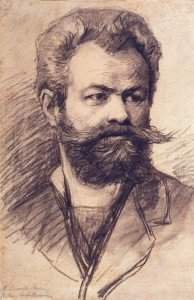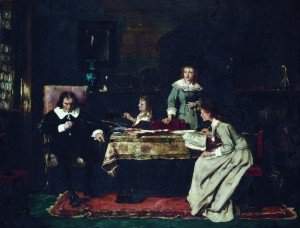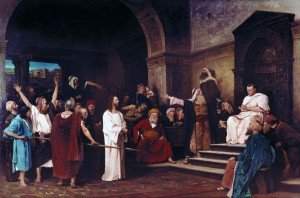20th of February – The birthday of Mihály Munkácsy, the famous Hungarian painter

Mihály Munkácsy is one of the most significant painters of the 19th century. Even today he is regarded as the greatest Hungarian painter by admirers, art historians and collectors of his paintings. Some of his paintings became world sensations as soon as he finished them; he was celebrated by art connoisseurs and the art-loving public of Europe, America and Hungary.
 According to munkacsyalapitvany.hu, Mihály Munkácsy was born as Mihály Lieb on February 20, 1844 in the town of Munkács, which was part of the Hungarian Kingdom at that time. The family was of Bavarian origin; his father, Leó Mihály Lieb was a governmental salt officer, and his mother, Cecília Reök, came from a gentry’s family. The artist began to use the Munkácsy name in 1863, but did not adopt it officially until 1868.
According to munkacsyalapitvany.hu, Mihály Munkácsy was born as Mihály Lieb on February 20, 1844 in the town of Munkács, which was part of the Hungarian Kingdom at that time. The family was of Bavarian origin; his father, Leó Mihály Lieb was a governmental salt officer, and his mother, Cecília Reök, came from a gentry’s family. The artist began to use the Munkácsy name in 1863, but did not adopt it officially until 1868.
After being apprenticed to itinerant painter Elek Szamossy, Munkácsy went to Pest, where he sought the patronage of some established artists. With the help of the landscapist Antal Ligeti he received a grant from the state so he could study abroad. In 1865, he studied at the Academy of Vienna under the patronage of Karl Rahl. In 1866, he went to Munich to study at the Academy, and in 1868 he moved to the Kunstakademie Düsseldorf to learn from the popular genre painter Ludwig Knaus. In 1867, he travelled to Paris to see the World Exhibition. After this trip his style became much lighter, with broader brushstrokes and tonal colour schemes.
His first significant painting, The Condemned Cell (1869-1870) received the gold medal of the Paris Salon. Another, Milton (1878), won the gold medal of the World Expo in Paris. His Christ Trilogy was admired by hundreds of thousands of people during its exhibition in Europe and in America. The press at the time followed the artist and reported regularly about his work and success. His works were often purchased immediately from the atelier by wealthy American and European collectors.

Mihály Munkácsy – Milton
Munkácsy’s success continues even today, as his paintings are the most frequently visited works in Hungarian public collections, and are sold at high prices at international art auctions. His good friend, Mihály Zichy, compared Munkácsy’s impact on Hungarian culture to that of the musician Ferenc Liszt: “Both of them […] acquired great reputation – The Condemned Cell, the Christ before Pilate and Milton remain works of art of imperishable value”. From the perspective of posterity, we can say that this and other predictions like such proved to be true.

Mihály Munkácsy – Christ before Pilate
Munkácsy died after long illness and suffering, in a state of unconsciousness on the 1st of May, 1900. On May 6th, his body was delivered to Budapest where it laid in state in the Art Gallery. A cordon was set up around the building and the catafalque could be visited only with an admission ticket. The burial took place on May 9th in the Kerepesi Cemetery. The outstanding figure of the Hungarian and European painting, the painter prince, was accompanied by hundreds of thousands of people at this end of his life’s journey.
Photos: www.munkacsyalapitvany.hu (Feauterd image: The Comdemned cell)
Copy editor: bm
Source: Daily News Hungary





